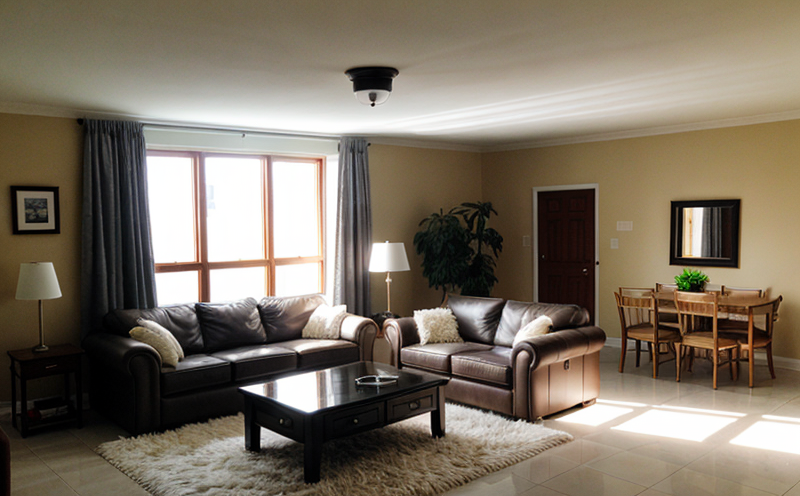ISO 23539 Indoor Lighting Testing of Photometric Quantities
The International Organization for Standardization (ISO) has established ISO 23539:2016, which specifies the procedures and methods to test indoor lighting fixtures regarding photometric quantities. This standard is essential for ensuring that lighting products meet the required performance levels in terms of luminance, light distribution, color rendering, and other critical parameters affecting human comfort and visual perception.
The standard applies universally across various sectors, including residential buildings, commercial spaces, and industrial environments. It aims to provide a harmonized approach to testing indoor lighting fixtures by defining clear procedures for measurement and evaluation. By adhering to ISO 23539, manufacturers can ensure their products meet the highest quality standards, thereby improving product reliability and market acceptance.
The core of ISO 23539 involves measuring photometric quantities such as luminous flux, illuminance, color temperature, and color rendering index. These parameters are crucial for determining how a lighting fixture will perform in real-world conditions. The standard provides detailed guidance on the equipment required, including photometers, integrating spheres, and colorimeters, along with specific procedures for their calibration and use.
For instance, luminous flux is measured using a photometer placed at a specified distance from the light source to ensure accurate readings. Illuminance measurements are taken over a defined area to assess how much light is distributed effectively. Color temperature is determined by comparing the correlated color temperature of the test sample with that of standard blackbody radiators. The color rendering index (CRI) evaluates the ability of a light source to accurately render colors.
The testing process typically involves preparing the specimen in a controlled environment that mimics real-world conditions as closely as possible. This preparation includes ensuring the lighting fixture is installed correctly and powered according to manufacturer specifications. Once prepared, the test setup replicates the intended use of the product, allowing for accurate photometric measurements.
The standard also addresses the importance of repeatability and reproducibility in testing results. Repeatability ensures that repeated tests under identical conditions yield consistent results, while reproducibility guarantees that different laboratories can achieve similar outcomes. This consistency is vital for maintaining high standards across the industry.
In summary, ISO 23539 provides a robust framework for testing indoor lighting fixtures regarding photometric quantities. By following this standard, manufacturers and quality assurance teams can ensure their products meet stringent performance criteria, enhancing both product reliability and customer satisfaction in the market.
Why It Matters
The importance of ISO 23539 cannot be overstated, especially in today's competitive lighting industry. Ensuring that indoor lighting fixtures meet photometric quantity standards is crucial for several reasons:
- Enhanced Visual Comfort: Properly designed and tested lighting can significantly reduce eye strain and improve visual comfort, leading to increased productivity and well-being.
- Energy Efficiency: Accurate photometric testing helps identify energy-efficient solutions that minimize power consumption without compromising on light quality.
- Safety Compliance: Meeting international standards like ISO 23539 ensures compliance with regulatory requirements, thereby reducing the risk of legal issues and enhancing brand reputation.
- Consistent Quality: By adhering to standardized testing procedures, manufacturers can ensure consistent product quality across different batches and production runs.
In conclusion, ISO 23539 plays a pivotal role in ensuring that indoor lighting fixtures are not only functional but also meet the highest standards of performance, safety, and energy efficiency. This standardization is essential for maintaining consumer trust and fostering innovation within the industry.
Customer Impact and Satisfaction
The implementation of ISO 23539 has a direct impact on customer satisfaction by addressing critical aspects of indoor lighting performance. Here’s how:
- Better Lighting Quality: Customers receive lights that provide optimal illumination, enhancing their daily activities.
- Energy Savings: Energy-efficient fixtures reduce utility bills and contribute to a greener environment.
- Improved Comfort: Properly tested lighting reduces eye strain and discomfort, leading to enhanced overall well-being.
- Enhanced Brand Reputation: Compliance with international standards boosts brand credibility and customer confidence.
In addition to these benefits, ISO 23539 also ensures that lighting fixtures meet the specific needs of end-users. For instance, healthcare facilities can choose lighting that minimizes glare while maximizing visibility, contributing to a safer environment for patients and staff. Similarly, educational institutions can benefit from fixtures that optimize learning conditions by reducing visual stress.
Customer satisfaction is further enhanced through transparent communication regarding product performance and compliance with international standards. This approach fosters trust and long-term relationships between manufacturers and their clients.
Competitive Advantage and Market Impact
Compliance with ISO 23539 offers significant competitive advantages in the lighting industry, contributing to market leadership:
- Regulatory Compliance: Meeting international standards ensures compliance with local regulations, opening up markets worldwide.
- Innovation and Differentiation: By staying ahead of regulatory changes and incorporating advanced testing methods, companies can differentiate their products from competitors.
- Prestige and Trust: Brands that comply with ISO 23539 are perceived as leaders in quality and innovation, attracting more customers.
- Long-Term Relationships: Satisfied customers lead to repeat business and referrals, strengthening market presence.
The standard also facilitates easier entry into international markets where regulatory compliance is a key factor. This streamlined process enhances operational efficiency and reduces costs associated with non-compliance.
In conclusion, ISO 23539 not only supports the technical aspects of lighting testing but also plays a crucial role in shaping market trends and customer expectations. By adhering to this standard, manufacturers can gain a competitive edge while ensuring high-quality products that meet global standards.





